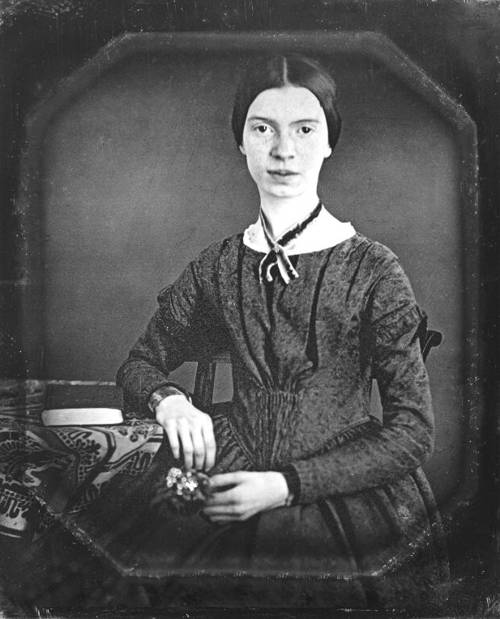
FAQ About Emily Dickinson

Who was Emily Dickinson?
Emily Dickinson was an American poet renowned for her introspective and innovative poetry. She was born on December 10, 1830, in Amherst, Massachusetts, and lived a mostly reclusive life, which greatly influenced her poetic work. Her poems often explore themes of identity, death, and nature, and she is considered one of the most significant figures in American literature. Despite her vast catalog of over 1,800 poems, only a few of them were published during her lifetime.

What are some common themes in Emily Dickinson's poetry?
Emily Dickinson's poetry touches on a variety of themes, but she is most known for her exploration of identity, death, and nature. Her work often reflects a deep introspection and a unique perspective on life. Other themes in her poetry include immortality, the self, solitude, and the beauty of the natural world. She frequently uses these themes to question and challenge the reader's understanding of existence and reality.

How did Emily Dickinson's lifestyle influence her poetry?
Emily Dickinson's reclusive lifestyle had a profound impact on her poetry. She spent much of her life at her family's home in Amherst, Massachusetts, often staying within its confines. This solitude allowed her space to observe the world intimately and reflect deeply on her own experiences. As a result, her poems often convey a sense of introspection and personal contemplation, exploring complex themes like death, loneliness, and identity. Her limited interaction with the outside world brought a unique focus and intensity to her work.

What is considered Emily Dickinson's most famous poem?
While Emily Dickinson wrote over 1,800 poems, "Because I could not stop for Death" is often cited as one of her most famous. The poem personifies death as a courteous gentleman who takes the speaker on a carriage ride, metaphorically illustrating the journey to eternity. Its exploration of immortality and the afterlife, coupled with its calm tone and vivid imagery, makes it a quintessential example of Dickinson's work.

When were Emily Dickinson's poems published?
Emily Dickinson's poems were largely unpublished during her lifetime. It was only after her death in 1886 that her work was discovered and the first volume of her poems was published posthumously in 1890. Subsequent collections were published as editors examined and organized her writings, and her complete works were not published in a single volume until 1955.

Did Emily Dickinson use any distinctive writing techniques?
Yes, Emily Dickinson is known for her distinctive writing style, which includes unconventional punctuation and capitalization as well as the use of short lines and slant rhyme. Her poetry often breaks the conventional rules of grammar and logic, which was innovative for her time. These techniques create a unique rhythm and emphasis that highlight the emotions and insights within her work, contributing to her recognition as a pioneering figure in modern poetry.

How did Emily Dickinson's poetry influence modern literature?
Emily Dickinson's poetry has had a lasting influence on modern literature by breaking traditional forms and exploring profound themes in concise and potent ways. Her innovative use of language, form, and syntax inspired later movements in poetry, including modernism and postmodernism. Her introspective style and emphasis on personal emotion and experience are seen as significant precursors to the confessional poets of the mid-20th century, such as Sylvia Plath and Anne Sexton.

Why is Emily Dickinson often referred to as a recluse?
Emily Dickinson is often described as a recluse because she spent most of her life in relative isolation. After her late twenties, she rarely left her family's home and communicated predominantly through letters. Her seclusion from society, along with the enigmatic nature of her interactions with the outside world, led to her reputation as a recluse. This isolation allowed her to focus intensely on her writing, resulting in the profound and personal nature of her poetry.

What is the significance of nature in Emily Dickinson's poetry?
Nature is a powerful and recurring motif in Emily Dickinson's poetry. She uses it as a lens through which she examines life's complexities and explores themes of death, immortality, and identity. Nature offers her a metaphorical language to reflect on human emotions and philosophical questions. Her close observation of the natural world results in vivid imagery and profound insight, illustrating her belief in nature as both a source of beauty and a profound connection to the cosmos.

Were any of Emily Dickinson's poems published during her lifetime?
Only a few of Emily Dickinson's poems were published during her lifetime, and those that were appeared anonymously and heavily edited to fit conventional standards of the time. It wasn't until after her death that her vast collection of poetry was fully discovered and published posthumously, revealing the richness and depth of her work to the wider world.

How did Emily Dickinson's upbringing affect her writing?
Emily Dickinson was raised in a prominent family in Amherst, Massachusetts, which valued education and intellectual pursuits. Her formal education included attending Amherst Academy and Mount Holyoke Female Seminary. This background provided her with a broad exposure to literature, religion, and science, all of which influenced her writing. Her father's political and legal career also exposed her to ideas and issues of the time, enriching the thematic complexity of her poetry.

What devices does Emily Dickinson commonly use in her poetry?
Emily Dickinson's poetry is known for its use of several distinctive literary devices, including slant rhyme, unconventional punctuation, and capitalizations. She also frequently employs metaphors and similes to convey complex themes succinctly. These devices serve to highlight the emotional intensity and philosophical depth of her work, offering readers a unique and often startling perspective on life and death.

What were the posthumous challenges in publishing Dickinson's work?
The posthumous publication of Emily Dickinson's work faced several challenges, including deciphering her handwriting, deciding on punctuation and capitalization, and interpreting her unconventional use of language. Early editors took liberties that deviated from her original style to make her poems more palatable to a 19th-century audience. It wasn't until later that her works were published in their original form, allowing readers to fully appreciate her innovative style.

Why is Emily Dickinson's poetry considered innovative for her time?
Emily Dickinson's poetry is considered innovative for its exploration of complex themes using concise language and bold imagery. Her use of unconventional grammar, punctuation, and capitalization also contributed to her distinctive voice. By diverging from traditional emotional expression and formal structures, Dickinson's work paved the way for modernist and experimental poetry, influencing writers for generations to come.

Did Emily Dickinson correspond with other literary figures of her time?
Emily Dickinson corresponded with several literary figures and intellectuals of her time through letters, which were her primary means of communication with the outside world. Most notably, she had an ongoing correspondence with Thomas Wentworth Higginson, an essayist and abolitionist, with whom she discussed literary ideas and sought critique for her work. These interactions provided her with both encouragement and a connection to broader literary movements.

How is death portrayed in Emily Dickinson's poetry?
Death is a central theme in Emily Dickinson's poetry, often portrayed with ambiguity and introspection. She explores death from multiple perspectives—as a final destination, a journey, or a companion—through varied tones ranging from acceptance to fear. Her innovative metaphorical expressions give depth to the subject, questioning and considering the mysteries of mortality and what lies beyond, making her treatment of death both universal and deeply personal.

What was the role of Emily Dickinson's family in preserving her work?
Emily Dickinson's family, especially her sister Lavinia, played a crucial role in preserving her work after her death. Finding Emily's vast collection of poems, Lavinia took responsibility for ensuring their publication. Though early editors altered Dickinson’s original works, Lavinia's initiative was essential in bringing Emily's expansive and influential body of work to public attention, shaping her posthumous reputation.

What is unique about Emily Dickinson's use of slant rhyme?
Emily Dickinson's use of slant rhyme (also known as near rhyme or half rhyme) is unique for its subtlety and musicality. Instead of using perfect rhymes, she often paired words that were phonetically similar but not identical, creating a dissonance that added to the emotional and rhythmic complexity of her poetry. This technique was unconventional at the time and contributed to the distinctive style and sound of her work.

How did societal norms of the 19th century affect Emily Dickinson's poetry?
The societal norms of the 19th century, particularly those concerning gender roles and restrictive expectations of women, influenced Emily Dickinson's poetry. Her reclusive lifestyle was partially a reaction to societal pressures, allowing her more freedom to express her thoughts and emotions candidly in her writing. Her poetry often subtly critiques these norms, using ambiguity and metaphor to explore themes of independence and personal identity.

What is the structure of Emily Dickinson's poems like?
Emily Dickinson's poems often feature a concise yet complex structure characterized by short stanzas, typically quatrains, and an economical use of language. She frequently employs iambic meter, common in hymnals, which contributes to the rhythm and flow of her poetry. Her structural innovations, including dashes for punctuation and irregular rhyme schemes, enhance the emotional and thematic depth of her work, making her poems distinctive and evocative.
